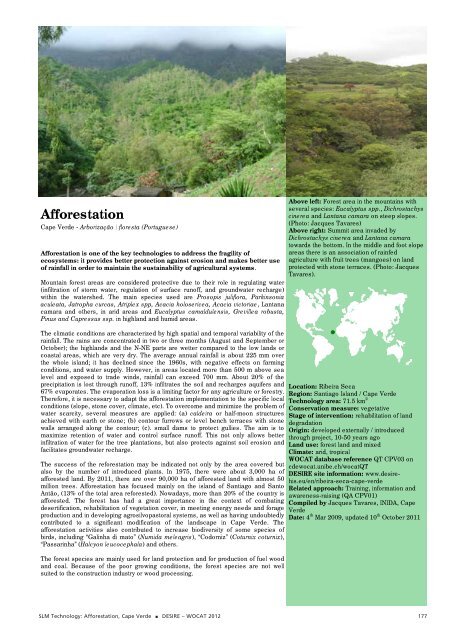Desire for Greener Land
Desire for Greener Land
Desire for Greener Land
You also want an ePaper? Increase the reach of your titles
YUMPU automatically turns print PDFs into web optimized ePapers that Google loves.
Af<strong>for</strong>estation<br />
Cape Verde - Arborização / floresta (Portuguese)<br />
Af<strong>for</strong>estation is one of the key technologies to address the fragility of<br />
ecosystems: it provides better protection against erosion and makes better use<br />
of rainfall in order to maintain the sustainability of agricultural systems.<br />
Mountain <strong>for</strong>est areas are considered protective due to their role in regulating water<br />
(infiltration of storm water, regulation of surface runoff, and groundwater recharge)<br />
within the watershed. The main species used are Prosopis juliflora, Parkinsonia<br />
aculeata, Jatropha curcas, Atriplex spp, Acacia holosericea, Acacia victoriae, Lantana<br />
camara and others, in arid areas and Eucalyptus camaldulensis, Grevillea robusta,<br />
Pinus and Cupressus ssp. in highland and humid areas.<br />
The climatic conditions are characterized by high spatial and temporal variability of the<br />
rainfall. The rains are concentrated in two or three months (August and September or<br />
October); the highlands and the N-NE parts are wetter compared to the low lands or<br />
coastal areas, which are very dry. The average annual rainfall is about 225 mm over<br />
the whole island; it has declined since the 1960s, with negative effects on farming<br />
conditions, and water supply. However, in areas located more than 500 m above sea<br />
level and exposed to trade winds, rainfall can exceed 700 mm. About 20% of the<br />
precipitation is lost through runoff, 13% infiltrates the soil and recharges aquifers and<br />
67% evaporates. The evaporation loss is a limiting factor <strong>for</strong> any agriculture or <strong>for</strong>estry.<br />
There<strong>for</strong>e, it is necessary to adapt the af<strong>for</strong>estation implementation to the specific local<br />
conditions (slope, stone cover, climate, etc). To overcome and minimize the problem of<br />
water scarcity, several measures are applied: (a) caldeira or half-moon structures<br />
achieved with earth or stone; (b) contour furrows or level bench terraces with stone<br />
walls arranged along the contour; (c). small dams to protect gullies. The aim is to<br />
maximize retention of water and control surface runoff. This not only allows better<br />
infiltration of water <strong>for</strong> the tree plantations, but also protects against soil erosion and<br />
facilitates groundwater recharge.<br />
The success of the re<strong>for</strong>estation may be indicated not only by the area covered but<br />
also by the number of introduced plants. In 1975, there were about 3,000 ha of<br />
af<strong>for</strong>ested land. By 2011, there are over 90,000 ha of af<strong>for</strong>ested land with almost 50<br />
million trees. Af<strong>for</strong>estation has focused mainly on the island of Santiago and Santo<br />
Antão, (13% of the total area re<strong>for</strong>ested). Nowadays, more than 20% of the country is<br />
af<strong>for</strong>ested. The <strong>for</strong>est has had a great importance in the context of combating<br />
desertification, rehabilitation of vegetation cover, in meeting energy needs and <strong>for</strong>age<br />
production and in developing agrosilvopastoral systems, as well as having undoubtedly<br />
contributed to a significant modification of the landscape in Cape Verde. The<br />
af<strong>for</strong>estation activities also contributed to increase biodiversity of some species of<br />
birds, including “Galinha di mato” (Numida meleagris), “Codorniz” (Coturnix coturnix),<br />
“Passarinha” (Halcyon leucocephala) and others.<br />
The <strong>for</strong>est species are mainly used <strong>for</strong> land protection and <strong>for</strong> production of fuel wood<br />
and coal. Because of the poor growing conditions, the <strong>for</strong>est species are not well<br />
suited to the construction industry or wood processing.<br />
SLM Technology: Af<strong>for</strong>estation, Cape Verde DESIRE – WOCAT 2012<br />
Above left: Forest area in the mountains with<br />
several species: Eucalyptus spp., Dichrostachys<br />
cinerea and Lantana camara on steep slopes.<br />
(Photo: Jacques Tavares)<br />
Above right: Summit area invaded by<br />
Dichrostachys cinerea and Lantana camara<br />
towards the bottom. In the middle and foot slope<br />
areas there is an association of rainfed<br />
agriculture with fruit trees (mangoes) on land<br />
protected with stone terraces. (Photo: Jacques<br />
Tavares).<br />
Location: Ribeira Seca<br />
Region: Santiago Island / Cape Verde<br />
Technology area: 71.5 km 2<br />
Conservation measure: vegetative<br />
Stage of intervention: rehabilitation of land<br />
degradation<br />
Origin: developed externally / introduced<br />
through project, 10-50 years ago<br />
<strong>Land</strong> use: <strong>for</strong>est land and mixed<br />
Climate: arid, tropical<br />
WOCAT database reference QT CPV03 on<br />
cdewocat.unibe.ch/wocatQT<br />
DESIRE site in<strong>for</strong>mation: www.desirehis.eu/en/ribeira-seca-cape-verde<br />
Related approach: Training, in<strong>for</strong>mation and<br />
awareness-raising (QA CPV01)<br />
Compiled by Jacques Tavares, INIDA, Cape<br />
Verde<br />
Date: 4 th Mar 2009, updated 10 th October 2011<br />
177









